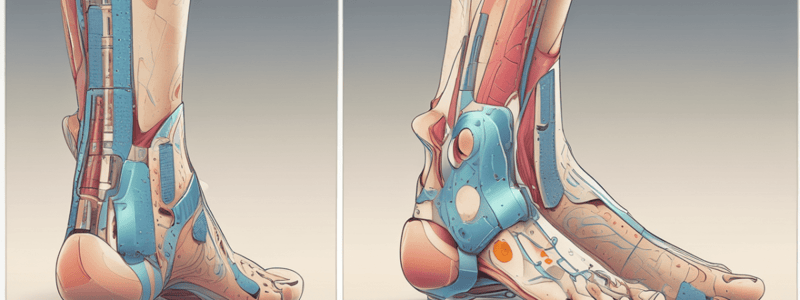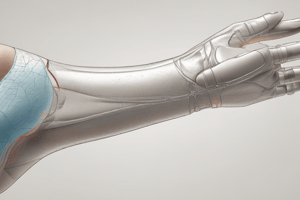Podcast
Questions and Answers
What is the anticipated deformity in the anterior neck region?
What is the anticipated deformity in the anterior neck region?
- Flexion with possible lateral flexion (correct)
- Extension with possible lateral flexion
- Hyperextension with possible lateral rotation
- Rotation with possible lateral flexion
What is the primary function of a soft cervical collar?
What is the primary function of a soft cervical collar?
- To promote flexion
- To maintain neck in neutral position (correct)
- To maintain neck in hyperextension
- To prevent lateral rotation
What is a major disadvantage of the molded neck splint?
What is a major disadvantage of the molded neck splint?
- It is not commercially available
- It is occlusive (correct)
- It is expensive
- It is heavy
In which phase of treatment is the molded neck splint typically used?
In which phase of treatment is the molded neck splint typically used?
What is a major advantage of the halo neck splint?
What is a major advantage of the halo neck splint?
What is a contraindication for using the halo neck splint?
What is a contraindication for using the halo neck splint?
How does the Watusi collar increase the degree of neck extension?
How does the Watusi collar increase the degree of neck extension?
What is a common problem associated with the use of the molded neck splint?
What is a common problem associated with the use of the molded neck splint?
Flashcards are hidden until you start studying
Study Notes
Regional Splints: Anterior Neck Region
- Anticipated deformity in anterior neck region: flexion with possible lateral flexion
- Secondary problems associated with deformity:
- Disturbance in mastication
- Distortion of facial units
- Difficult or hazardous intubation in subsequent reconstructive procedures
Splints for Neck Region
-
Soft cervical collar:
- Description: circumferential foam, rubber orthosis
- Function: maintain neck in neutral position, prevent lateral flexion
- Advantages:
- Commercially available
- Simple to apply and adjust
- Comfortable
- Lightweight
- Disadvantages:
- Absorbent
- Tendency to rotate around neck
- Minimal effectiveness for scar tissue reduction
-
Molded neck splint:
- Description: total contact rigid neck support (thermoplastic)
- Advantages:
- Used in 3rd phase of treatment
- Low temperature material direct molded
- High temp.indirect molded on patient
- Maintain exact position, prevent rotation and lateral flexion
- Disadvantages:
- Occlusive
- Skin breakdown in bony area (pressure point at clavicle and chin)
-
Halo-neck splint:
- Description: thermoplastic, puts neck in extension using head and upper torso for stabilization
- Advantages:
- Used in any phase of treatment
- Allow frequent care of new skin graft
- Permit visualization of wound
- Disadvantages:
- Contraindicated for deep burn over forehead
- Strapping may cause wound breakdown
- Doesn't prevent shortening of anterior neck secondary to opening mouth
- Uncomfortable in supine position
-
Watusi collar:
- Description: series of cylindrical plastic tubes encircling the neck, made from thermoplastic material
- Function: increase degree of neck extension by adding additional tubes
Studying That Suits You
Use AI to generate personalized quizzes and flashcards to suit your learning preferences.



